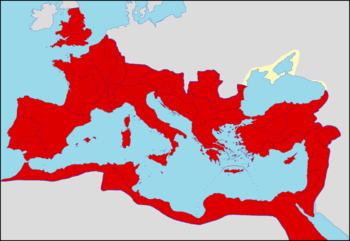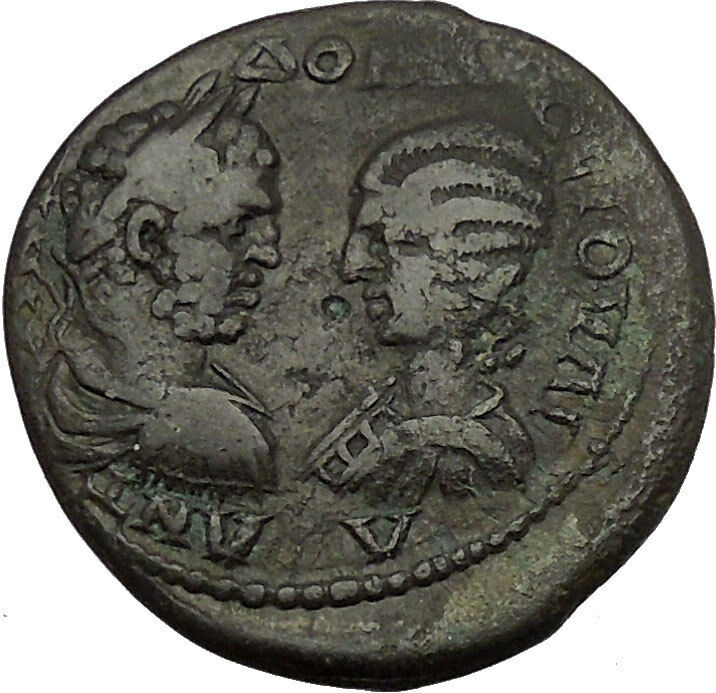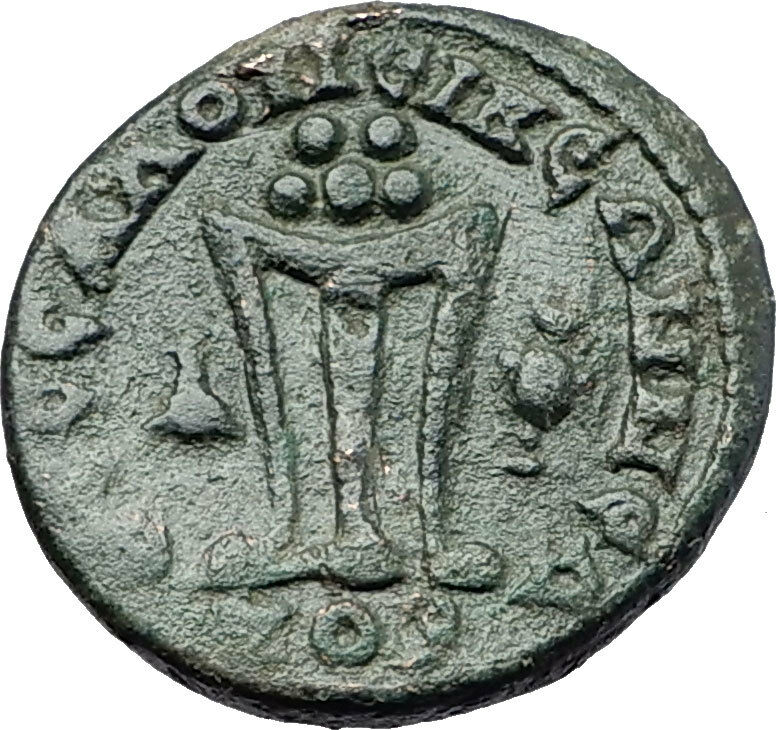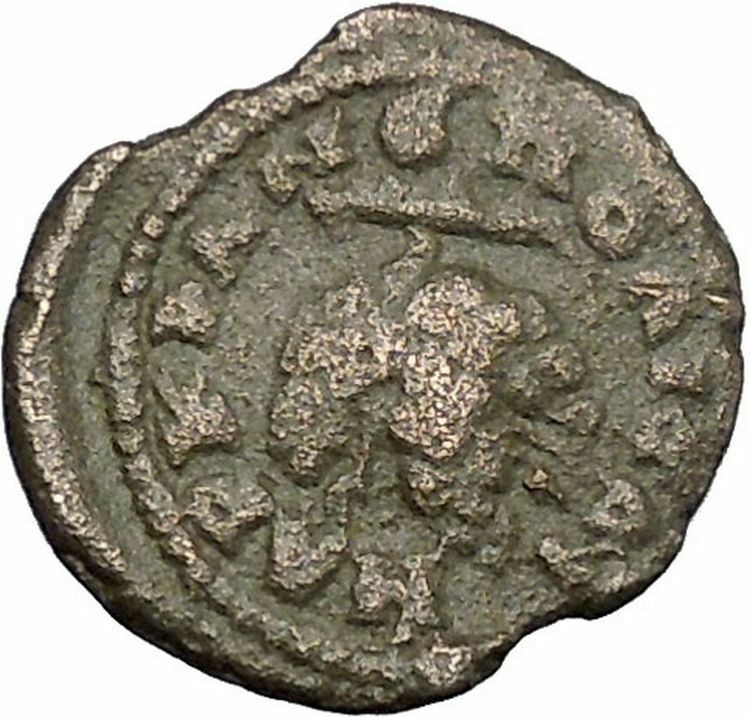|
Caracalla – Roman Emperor: 198-217 A.D.
Caracalla & Julia Domna
Bronze 27mm (14.07 grams) of Marcianopolis in Moesia Inferior under Magistrate Quintillianus
Laureate, draped and cuirassed bust of of Caracalla on left facing right toward draped bust of Julia Domna on right facing left.
VΠ KVNTIΛIANOV MAPKIANOΠOΛITΩN, Tyche standing left holding a rudder and cornucopia; Є (value mark) in field to left.
You are bidding on the exact item pictured, provided with a Certificate of Authenticity and Lifetime Guarantee of Authenticity.
 Tyche (meaning “luck”; Roman equivalent: Fortuna) was the presiding tutelary deity that governed the fortune and prosperity of a city, its destiny. She is the daughter of Aphrodite and Zeus or Hermes. Tyche (meaning “luck”; Roman equivalent: Fortuna) was the presiding tutelary deity that governed the fortune and prosperity of a city, its destiny. She is the daughter of Aphrodite and Zeus or Hermes.
In literature, she might be given various genealogies, as a daughter of Hermes and Aphrodite, or considered as one of the Oceanids, daughters of Oceanus and Tethys, or of Zeus. She was connected with Nemesis and Agathos Daimon (“good spirit”).
The Greek historian Polybius believed that when no cause can be discovered to events such as floods, droughts, frosts or even in politics, then the cause of these events may be fairly attributed to Tyche.
Worship
Increasingly during the Hellenistic period, cities venerated their own specific iconic version of Tyche, wearing a mural crown (a crown like the walls of the city).
Tyche had temples at Caesarea Maritima, Antioch, Alexandria and Constantinople. In Alexandria the Tychaeon, the temple of Tyche, was described by Libanius as one of the most magnificent of the entire Hellenistic world.
She was uniquely venerated at Itanos in Crete, as Tyche Protogeneia, linked with the Athenian Protogeneia (“firstborn”), daughter of Erechtheus, whose self-sacrifice saved the city.
Stylianos Spyridakis concisely expressed Tyche’s appeal in a Hellenistic world of arbitrary violence and unmeaning reverses: “In the turbulent years of the Epigoni of Alexander, an awareness of the instability of human affairs led people to believe that Tyche, the blind mistress of Fortune, governed mankind with an inconstancy which explained the vicissitudes of the time.”
Depictions
Tyche appears on many coins of the Hellenistic period in the three centuries before the Christian era, especially from cities in the Aegean. Unpredictable turns of fortune drive the complicated plotlines of Hellenistic romances, such as Leucippe and Clitophon or Daphnis and Chloe. She experienced a resurgence in another era of uneasy change, the final days of publicly sanctioned Paganism, between the late-fourth-century emperors Julian and Theodosius I who definitively closed the temples. The effectiveness of her capricious power even achieved respectability in philosophical circles during that generation, though among poets it was a commonplace to revile her for a fickle harlot.
In medieval art, she was depicted as carrying a cornucopia, an emblematic ship’s rudder, and the wheel of fortune, or she may stand on the wheel, presiding over the entire circle of fate.
The constellation of Virgo is sometimes identified as the heavenly figure of Tyche, as well as other goddesses such as Demeter and Astraea.
Marcianopolis, or Marcianople was an ancient Roman city in Thracia. It was located at the site of modern day Devnya, Bulgaria.
The city was so renamed by Emperor Trajan after his sister Ulpia Marciana, and was previously known as Parthenopolis. Romans repulsed a Gothic attack to this town in 267 (or 268), during the reign of Gallienus. Diocletian made it the capital of the Moesia Secunda province.
Valens made it his winter quarters in 368 and succeeding years, Emperor Justinian I restored and fortified it. In 587, it was sacked by the king of the Avars but at once retaken by the Romans. The Roman army quartered there in 596 before crossing the Danube to assault the Avars.
Between 893 and 972 it was one of the most important medieval cities in south-eastern Europe.
 Julia Domna – Augusta 193-217 A.D. Julia Domna – Augusta 193-217 A.D.
| Wife of Septimius Severus | Mother of Caracalla and Geta | Sister of Julia Maesa | Aunt of Julia Soaemias and Julia Mamaea | Great-aunt of Elagabalus and Severus Alexander | Mother-in-law of Plautilla |
Julia Domna, (Latin: Iulia Domna; c. 170 AD – 217 AD) was a member of the Severan dynasty of the Roman Empire. Empress and wife of Roman Emperor Lucius Septimius Severus and mother of Emperors Geta and Caracalla, Julia was famous for her prodigious learning as well as her extraordinary political influence.
 Caracalla 198-217 A.D. Caracalla 198-217 A.D.
Caesar: 195-198 A.D. (under <font ioniaSeptimius Severus)
Augustus: 198-217 A.D. (198-209 A.D. with <font ioniaSeptimius Severus) (209-211 A.D. with <font ioniaSeptimius Severus and Geta) (211 A.D. with Geta) (211-217 A.D. Sole Reign)
Son of <font ioniaSeptimius Severus and <font ioniaJulia Domna | Brother of Geta | Husband of <font ioniaPlautilla | Nephew of <font ioniaJulia Maesa | Cousin of <font ioniaJulia Soaemias and <font ioniaJulia Mamaea |
Caracalla (4 April 188 – 8 April 217), formally Marcus Aurelius Severus Antoninus Augustus, was Roman emperor from AD 198 to 217. A member of the Severan Dynasty, he was the eldest son of Septimius Severus and Julia Domna. Caracalla reigned jointly with his father from 198 until Severus’ death in 211. Caracalla then ruled jointly with his younger brother Geta, with whom he had a fraught relationship, until he had Geta murdered later that year. Caracalla’s reign was marked by domestic instability and external invasions from the Germanic people.
Caracalla’s reign was notable for the Antonine Constitution (Latin: Constitutio Antoniniana), also known as the Edict of Caracalla, which granted Roman citizenship to nearly all freemen throughout the Roman Empire. The edict gave all the enfranchised men Caracalla’s adopted praenomen and nomen: “Marcus Aurelius”. Domestically, Caracalla was known for the construction of the Baths of Caracalla, which became the second-largest baths in Rome, for the introduction of a new Roman currency named the antoninianus, a sort of double denarius, and for the massacres he enacted against the people of Rome and elsewhere in the empire. Towards the end of his rule, Caracalla began a campaign against the Parthian Empire. He did not see this campaign through to completion due to his assassination by a disaffected soldier in 217. He was succeeded as emperor by Macrinus after three days.
Caracalla is presented in ancient sources as a tyrant and cruel leader, an image that has survived into modernity. Dio Cassius and Herodian present Caracalla as a soldier first and emperor second. In the 12th century, Geoffrey of Monmouth started the legend of Caracalla’s role as the king of Britain. Later, in the 18th century, Caracalla’s memory was revived in the works of French artists due to the parallels between Caracalla’s apparent tyranny and that of King Louis XVI. Modern works continue to portray Caracalla as a psychopathic and evil ruler. His rule is remembered as being one of the most tyrannical of all Roman emperors.
Names
Caracalla was born Lucius Septimius Bassianus. He was renamed Marcus Aurelius Antoninus at the age of seven as part of his father’s attempt at union with the families of Antoninus Pius and Marcus Aurelius. According to Aurelius Victor in his Epitome de Caesaribus, he became known by the agnomen “Caracalla” after a Gallic hooded tunic that he habitually wore and made fashionable. He may have begun wearing it during his campaigns on the Rhine and Danube. Dio generally referred to him as Tarautas, after a famously diminutive and violent gladiator of the time.
Life
Early life
Caracalla was born in Lugdunum, Gaul (now Lyon, France), on 4 April 188 to Septimius Severus and Julia Domna. He had a slightly younger brother, Geta, who would briefly rule as co-emperor alongside him. Caracalla’s father, Septimius Severus, appointed Caracalla joint Augustus and full emperor from the year 198 onwards. His brother Geta was granted the same title in 210. In 202 Caracalla was forced to marry the daughter of Gaius Fulvius Plautianus, Fulvia Plautilla, a woman whom he hated, though for what reason is unknown. By 205 Caracalla had succeeded in having Plautianus executed for treason, though he had probably fabricated the evidence of the plot himself. It was then that he banished his wife, whose later killing might have been carried out under Caracalla’s orders.
Reign
Brother’s Murder
Caracalla’s father, Septimius Severus, died on 4 February 211 at Eboracum (now York) while on campaign in Caledonia, north of the Roman Britannia. Caracalla and his brother, Publius Septimius Antoninus Geta, jointly inherited the throne upon their father’s death. Caracalla and Geta ended the campaign in Caledonia after concluding a peace with the Caledonians that returned the border of Roman Britain to the line demarcated by Hadrian’s Wall. During the journey back to Rome with their father’s ashes, Caracalla and his brother continuously argued with one another, making relations between them increasingly hostile. Caracalla and Geta considered dividing the empire in half along the Bosphorus to make their co-rule less hostile. Caracalla was to rule in the west and Geta was to rule in the east. They were persuaded not to do this by their mother.
On 26 December 211, at a reconciliation meeting arranged by their mother, Caracalla had Geta assassinated by members of the Praetorian Guard loyal to himself, Geta dying in his mother’s arms. Caracalla then persecuted and executed most of Geta’s supporters and ordered a damnatio memoriae pronounced by the Senate against his brother’s memory. Geta’s image was removed from all paintings, coins were melted down, statues were destroyed, his name was struck from papyrus records, and it became a capital offence to speak or write Geta’s name. In the aftermath of the damnatio memoriae, an estimated 20,000 people were massacred. Those killed were Geta’s inner circle of guards and advisers, friends, and other military staff under his employ.
Provincial tours

The Roman Empire during the reign of Caracalla
In 213, about a year after Geta’s death, Caracalla left Rome never to return. He went north to the German frontier to deal with the Alamanni and Goths tribesmen, a confederation of migrating Germanic tribes who had broken through the limes in Raetia. During the campaign of 213-214, Caracalla successfully defeated some of the Germanic tribes while settling other difficulties through diplomacy, though precisely with whom these treaties were made remains unknown. While there, Caracalla strengthened the frontier fortifications of Raetia and Germania Superior, collectively known as the Agri Decumates, so that it was able to withstand any further barbarian invasions for another twenty years. Historian Edward Gibbon compares Caracalla to emperors such as Hadrian who spent their careers campaigning in the provinces and then to tyrants such as Nero and Domitian whose entire reigns were confined to Rome and whose actions only impacted upon the senatorial and equestrian classes residing there. Gibbon then concludes that Caracalla was “the common enemy of mankind”, as both Romans and provincials alike were subject to “his rapine and cruelty”.
After Caracalla concluded his campaign against the Alamanni, it became evident that he was inordinately preoccupied with the Greek-Macedonian general and conqueror Alexander the Great. He began openly mimicking Alexander in his personal style. In planning his invasion of the Parthian Empire, Caracalla decided to equip 16,000 of his men with Macedonian-style phalanxes, despite the Roman army having made the phalanx an obsolete tactical formation. The historian Christopher Matthew mentions that the term Phalangarii has two possible meanings, both with military connotations. The first refers merely to the Roman battle line and does not specifically mean that the men were armed with pikes, and the second bears similarity to the ‘Marian Mules’ of the late Roman Republic who carried their equipment suspended from a long pole, which were in use until at least the 2nd century AD. As a consequence, the Phalangarii of Legio II Parthica may not have been pikemen, but rather standard battle line troops or possibly Triarii. Caracalla’s mania for Alexander went so far that Caracalla visited Alexandria while preparing for his Persian invasion and persecuted philosophers of the Aristotelian school based on a legend that Aristotle had poisoned Alexander. This was a sign of Caracalla’s increasingly erratic behaviour. But this mania for Alexander, strange as it was, was overshadowed by subsequent events in Alexandria.
When the inhabitants of Alexandria heard of Caracalla’s claims that he had killed his brother Geta in self-defence, they produced a satire mocking this as well as Caracalla’s other pretensions. In 215 Caracalla travelled to Alexandria and responded to this insult by slaughtering the deputation of leading citizens who had unsuspectingly assembled before the city to greet his arrival, before setting his troops against Alexandria for several days of looting and plunder. Following the massacre at Alexandria, Caracalla moved east onto Armenia. By 216 he had pushed through Armenia and south into Parthia.
Julia Domna
During the reign of Septimius Severus, Julia Domna had played a prominent public role, receiving titles of honor such as “Mother of the camp”, but she also played a role behind the scenes helping Septimius administer the empire. Described as ambitious, Julia Domna surrounded herself with thinkers and writers from all over the empire. While Caracalla was mustering and training troops for his planned Persian invasion, Julia remained in Rome, administering the empire. Julia’s growing influence in state affairs was the beginning of a trend of emperors’ mothers having influence, which continued throughout the Severan dynasty.
When Geta died in 211, her responsibilities increased because Caracalla found administrative tasks to be mundane. She may have taken upon one of the more important civil functions of the emperor; receiving petitions and answering correspondence. The extent of her role in this position, however, is probably overstated. She may have represented her son and played a role in meetings and answering queries; however, the final authority on legal matters was Caracalla. When Caracalla was murdered, Julia was in Antioch sorting out correspondence, removing unimportant messages from the bunch so that when Caracalla returned, he would not be overburdened with duties. The emperor filled all of the roles in the legal system as judge, legislator, and administrator.
Army policy
During his reign as emperor, Caracalla raised the annual pay of an average legionary from 2000 sesterces (500 denarii) to 2700-3000 sesterces (675-750 denarii). He lavished many benefits on the army, which he both feared and admired, in accordance with the advice given by his father on his deathbed always to heed the welfare of the soldiers and ignore everyone else. Caracalla needed to gain and keep the trust of the military, and he did so with generous pay raises and popular gestures. He spent much of his time with the soldiers, so much so that he began to imitate their dress and adopt their manners.
Baths

The Baths of Caracalla
Construction on the Baths of Caracalla began in 211 at the start of Caracalla’s rule. The baths are named for Caracalla, though it is most probable that his father was responsible for their planning. In 216 a partial inauguration of the baths took place, but the outer perimeter of the baths was not completed until the reign of Severus Alexander. These large baths were typical of the Roman practice of building complexes for social and state activities in large densely populated cities. The baths covered around 50 acres (or 202,000 square meters) of land and could accommodate around 1,600 bathers at any one time. They were the second largest public baths built in ancient Rome and were complete with swimming pools, exercise yards, a stadium, steam rooms, libraries, meeting rooms, fountains, and other amenities, all of which were enclosed within formal gardens. The interior spaces were decorated with colourful marble floors, columns, mosaics, and colossal statuary.
Caracalla and Serapis
At the outset of his reign, Caracalla declared divine support for Egyptian deity Serapis – a god of healing. The Iseum et Serapeum in Alexandria was apparently renovated during Caracalla’s co-rule with his father Septimius Severus. The evidence for this exists in two inscriptions found near the temple that appear to bear their names. Additional archaeological evidence exists for this in the form of two papyrii that have been dated to the Severan period and also two statues associated with the temple that have been dated to around 200 AD. Upon Caracalla’s ascension to sole ruler in 212, the imperial mint began striking coins bearing Serapis’ image. This was a reflection of the god’s central role during Caracalla’s reign. After Geta’s death, the weapon that had killed him was dedicated to Serapis by Caracalla. This was most likely done to cast Serapis into the role of Caracalla’s protector from treachery.
Caracalla also erected a temple on the Quirinal Hill in 212, which he dedicated to Serapis. A fragmented inscription found in the church of Sant’ Agata dei Goti in Rome records the construction, or possibly restoration, of a temple dedicated to the god Serapis. The inscription bears the name “Marcus Aurelius Antoninus”, a reference to either Caracalla or Elagabalus, but more likely to Caracalla due to his known strong association with the god. Two other inscriptions dedicated to Serapis, as well as a granite crocodile similar to one discovered at the Iseum et Serapeum, were also found in the area around the Quirinal Hill.
Constitutio Antoniniana
The Constitutio Antoniniana (lit. “Constitution of Antoninus”, also called “Edict of Caracalla” or “Antonine Constitution”) was an edict issued in 212 by Caracalla declaring that all free men in the Roman Empire were to be given full Roman citizenship, with the exception of the dediticii, people who had become subject to Rome through surrender in war, and certain freed slaves. Whether the dediticii were excepted from the decree is a matter of debate.
Before 212 the majority of Roman citizens had been inhabitants of Roman Italia, with about 4-7% of all peoples in the Roman empire being Roman citizens at the time of the death of Augustus in 14 AD. Outside Rome, citizenship was restricted to Roman coloniae – Romans, or their descendants, living in the provinces, the inhabitants of various cities throughout the Empire – and small numbers of local nobles such as kings of client countries. Provincials, on the other hand, were usually non-citizens, although some Magistrates and their families and relatives held the Latin Right.
Dio maintains that one purpose for Caracalla issuing the edict was the desire to increase state revenue; at the time, Rome was in a difficult financial situation and needed to pay for the new pay raises and benefits that were being conferred on the military. The edict widened the obligation for public service and gave increased revenue through the inheritance and emancipation taxes that only had to be paid by Roman citizens. The provincials also benefited from this edict because they were now able to think of themselves as equal partners to the Romans in the empire. However, few of those that gained citizenship were wealthy, and while it is true that Rome was in a difficult financial situation, it is thought that this could not have been the sole purpose of the edict.
Another purpose for issuing the edict, as described within the papyrus upon which part of the edict was inscribed, was to appease the gods who had delivered Caracalla from conspiracy. The conspiracy in question was in response to Caracalla’s murder of Geta and the subsequent slaughter of his followers; fratricide would only have been condoned if his brother had been a tyrant. The damnatio memoriae against Geta and the large payments Caracalla had made to his own supporters were designed to protect himself from possible repercussions. After this had succeeded, Caracalla felt the need to repay the gods of Rome by returning the favour to the people of Rome through a similarly grand gesture. This was done through the granting of citizenship.
Another purpose for issuing the edict might have been related to the fact that the periphery of the empire was now becoming central to its existence, and the granting of citizenship may have been simply a logical outcome of Rome’s continued expansion of citizenship rights.
Monetary policy
The expenditures that Caracalla made with the large bonuses he gave to soldiers prompted him to debase the coinage soon after his ascension. At the end of Severus’ reign, and early into Caracalla’s, the Roman denarius had an approximate silver purity of around 55%, but by the end of his reign the purity had been reduced to about 51%.
In 215 Caracalla introduced the antoninianus, a coin intended to serve as a double denarius. This new currency, however, had a silver purity of about 52% for the period between 215 and 217 and an actual size ratio of 1 antoninianus to 1.5 denarii. This in effect made the antoninianus equal to about 1.5 denarii. The reduced silver purity of the coins caused people to hoard the old coins that had higher silver content, making the inflation problem caused by the earlier devaluation of the denarii worse than it had been before.
Parthian war
In 216 Caracalla pursued a series of aggressive campaigns in the east against the Parthians, intended to bring more territory under direct Roman control. He offered the king of Parthia, Artabanus V of Parthia, a marriage proposal between himself and the king’s daughter. Artabanus refused the offer, realizing that the proposal was merely an attempt to unite the kingdom of Parthia under the control of Rome. In response, Caracalla used the opportunity to start a campaign against the Parthians. That summer Caracalla began to attack the countryside east of the Tigris in the Parthian war of Caracalla. In the following winter, Caracalla retired to Edessa, modern Şanlıurfa in south-east Turkey, and began making preparations to renew the campaign by spring.
Death
At the beginning of 217, Caracalla was at Edessa with a large army preparing to start a new invasion of Parthia. On 8 April 217 Caracalla was travelling to visit a temple near Carrhae, now Harran in southern Turkey, where in 53 BC the Romans had suffered a defeat at the hands of the Parthians. After stopping briefly to urinate, Caracalla was approached by a soldier, Justin Martialis, and stabbed to death. Martialis had been incensed by Caracalla’s refusal to grant him the position of centurion, and the Praetorian Guard Prefect Macrinus, Caracalla’s successor, saw the opportunity to use Martialis to end Caracalla’s reign. In the immediate aftermath of Caracalla’s death, his murderer, Martialis, was killed as well. Three days later, Macrinus declared himself emperor with the support of the Roman army.
|





 Tyche (meaning “luck”; Roman equivalent: Fortuna) was the presiding tutelary deity that governed the fortune and prosperity of a city, its destiny. She is the daughter of Aphrodite and Zeus or Hermes.
Tyche (meaning “luck”; Roman equivalent: Fortuna) was the presiding tutelary deity that governed the fortune and prosperity of a city, its destiny. She is the daughter of Aphrodite and Zeus or Hermes. Julia Domna – Augusta 193-217 A.D.
Julia Domna – Augusta 193-217 A.D. Caracalla 198-217 A.D.
Caracalla 198-217 A.D.






